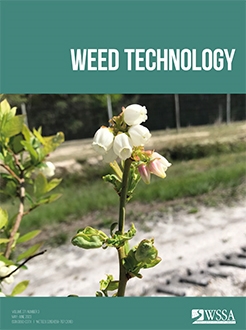Invasive emergent and floating macrophytes can have detrimental impacts on aquatic ecosystems. Management of these aquatic weeds frequently relies upon foliar application of aquatic herbicides. However, there is inherent variability of overspray (herbicide loss) for foliar applications into waters within and adjacent to the targeted treatment area. The spray retention (tracer dye captured) of four invasive broadleaf emergent species (water hyacinth, alligatorweed, creeping water primrose, and parrotfeather) and two emergent grass-like weeds (cattail and torpedograss) were evaluated. For all species, spray retention was simulated using foliar applications of rhodamine WT (RWT) dye as a herbicide surrogate under controlled mesocosm conditions. Spray retention of the broadleaf species was first evaluated using a CO2-pressurized spray chamber overtop dense vegetation growth or no plants (positive control) at a greenhouse (GH) scale. Broadleaf species and grass-like species were then evaluated in larger outdoor mesocosms (OM). These applications were made using a CO2-pressurized backpack sprayer. Evaluation metrics included species-wise canopy cover and height influence on in-water RWT concentration using image analysis and modeling techniques. Results indicated spray retention was greatest for water hyacinth (GH, 64.7 ± 7.4; OM, 76.1 ± 3.8). Spray retention values were similar among the three sprawling marginal species alligatorweed (GH, 37.5 ± 4.5; OM, 42 ± 5.7), creeping water primrose (GH, 54.9 ± 7.2; OM, 52.7 ± 5.7), and parrotfeather (GH, 48.2 ± 2.3; OM, 47.2 ± 3.5). Canopy cover and height were strongly correlated with spray retention for broadleaf species and less strongly correlated for grass-like species. Although torpedograss and cattail were similar in percent foliar coverage, they differed in percent spray retention (OM, 8.5± 2.3 and 28.9 ±4.1, respectively). The upright leaf architecture of the grass-like species likely influenced the lower spray retention values in comparison to the broadleaf species.
Nomenclature: Alligatorweed; Alternanthera philoxeroides (Mart.) Griseb.; cattail; Typha latifolia L.; creeping water primrose; Ludwigia grandiflora (Michx.) Greuter & Burdet; parrotfeather; Myriophyllum aquaticum (Vell.) Verdc.; torpedograss Panicum repens L.; water hyacinth; Eichhornia crassipes (Mart.) Solms






